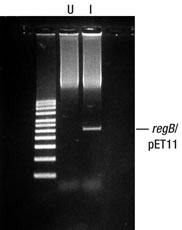CopyCutter™ EPI400™ E.coli* cells were developed to significantly lower the copy number of a wide variety of common vectors so that you can more readily clone unstable DNA sequences. DNA that is unstable at high-copy number often codes for a protein that inhibits cell growth or contains AT- and GC-rich sequences or sequences with strong secondary structure (Figure 1).
The CopyCutter™ EPI400™ cell line was derived from our high-transformation efficiency phage T1-resistant TransforMax™ EC100™ E. coli strain by manipulating a gene that controls the copy number of vectors containing ColE1 or pMB1 origins of replication (e.g., pUC- and pET-type vectors). This constitutively expressed gene, pcnB (plasmid copy number), was deleted from the TransforMax™ EC100™ strain and replaced with a modified pcnB gene that is linked to an inducible promoter, creating the CopyCutter™ EPI400™ strain.
The copy number of ColE1-type vectors in the CopyCutter™ EPI400™ strain compared to the parental TransforMax™ EC100™ strain is approximately 4- to 25-fold lower, depending on the vector. Moreover, following a short incubation in the presence of the CopyCutter™ Induction Solution, you can increase the copy number of the vector to improve plasmid yields (Figure 2).
*Covered by issued and/or pending patents.
 |
 |
| Figure 1. DNA inserts encoding toxic gene products were successfully cloned into high-copy number vectors using CopyCutter™ EPI400™ E. coli cells After sequencing, the full-length acpP clones in TransforMAX™ EC100™ cells were found to contain multiple point mutations. |
Figure 2. Uninduced CopyCutter™ EPI400™ E. coli cells containing a regB clone (Lane U) are induced to higher-copy number (Lane I) using the CopyCutter™ Induction Solution. Crude extracts of plasmid DNA were prepared from cells grown in selective media and analyzed by agarose gel electrophoresis. Approximately the same number of lysed cells (based on OD600) were loaded per lane. |
Genotype
F- mcrA Δ(mrr-hsdRMS-mcrBC) φ80dlacZΔM15 ΔlacX74 recA1 endA1 araD139 Δ(ara, leu)7697 galU galK λ- rpsL nupG trfA tonA pcnB4 dhfr
CopyCutter™ EPI400™ Electrocompetent E. coli
Transformation efficiency of >1 X 1010 cfu/µg of pUC19.
- Supplied in convenient single-use 50-µl volumes.
CopyCutter™ EPI400™ Chemically Competent E. coli
Transformation efficiency of >1 x 108 cfu/µg of pUC19.
- Supplied in convenient single-use 50-µl volumes.
If you cannot find the answer to your problem then please contact us or telephone +44 (0)1954 210 200